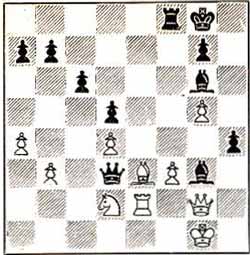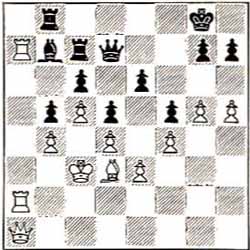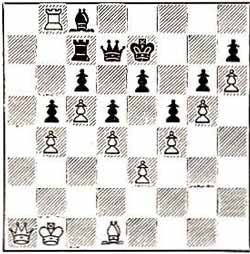|
R A D I O M A T C H R E V I E W E D
|
||
9. Abraham Kupchik vs. Vladimir Makogonov Game 1 notes by Fred Reinfeld Game 2 notes by Miguel Czerniak CHESS REVIEW APRIL 1946 |
29 N-N2 Q-KB2 Or 32 NxB, QxN followed by….B-B5 or ... N-B5 with an irresistible bind on the position
32 . . . . BxN The blows come thick and fast from all sides.
37 K-R2 B-Q3ch
Black threatens 40 ... P-R6 with crushing effect. 40 N-B1 . . . . If 40 K-Bl, B-R4 and White has no moves. 40 . . . . P-R6
White resigns. He loses the exchange and is left with a
hopeless position.
|
|
|
Catalan System A. Kupchik
V. Makogonov 1 P-Q4
N-KB3 The usual move isB-N5, lending to the orthodox varieties of the Queen's Gambit Declined. The text is played with a view to transposing into the most favorable variation of Reti's Opening, namely a line of play in which Black's QB Is often hemmed in for a long time. By way of illustration, see the game between Bondarevsky and Steiner in this match. 5 . . . .
QN-Q2 But this is the move that spoils
the game for White. It puts an end to the pressure which his fianchettoed
KB is to exert in the center, as the Pawn position will no longer be
fluid. In addition, it opens valuable lines for Black: the King file for
his Rooks and the diagonal for his Queen's Bishop. 6 . . . . PxP Now Black has a very promising position. 7 B-N2
P-B3
10 P-KR3 . . . .
|
10. . . . B-Q3 Training the Bishop on White’s weakened King•side and at the same time restraining White playing P~K4. 11 N-Q2 N-N3 So that If 12 P-K4, PxP: 13 KNxP, B-KB4 and White's game is very uncomfortable.
12 R-K1
B-K3 White's game now becomes so cramped that he was probably better off with a last attempt at P-K4 here.
13. . . .
Q-Q2 A position made to order for Makogonov, who is both methodical and enterprising, Black naturally plays to open more attacking lines.
17 P-N5
P-B5! Now Black wins a valuable Pawn, and still continues his hammer•blows at White's position.
23 P-K4
PxPe.p.
|
|
|
||
|
QUEEN'S PAWN OPENING V. Makogonov
A. Kupchik 1 P-Q4
N-KB3 What little analysis exists on this infrequently seen opening system, tells us that 3 ... P-B4 is the most enterprising reply. The line selected by Kupchik is unpretentious but solid 4 P-K3
B-Q3 In the 17th game of the Alekhine-Euwe match, after 1 P-Q4, P-Q4; 2 N-KB3, N-KB3; 3 P-K3. B-B4; 4 B-Q3, Black played 4 ... P-K3! so as to gain a powerful foothold in the center after the exchange of Bishops. By the same token, White should have played 5 P-K3 in the present game. 5 . . . .
N-K5 If 10 O-O, BxB; 11 RPxB, N-Q2 followed by ... P-B3 and.. Q-B3 with a good game for Black. 10 . . . .
QxB There is no time to prevent N-K5, for 11 ...N- Q2? 12 N-QN5, Q-B3; 13 PxP winning a pawn. 12 N-K5
NxN Or 14 P-B4,N-B3 etc. After the text simplification, the most that White can hope for is restricting the hostile Bishop’s sphere of action. 14 . . . .
QxN
|
17. . . .
QR-N1 Doubling and tripling on the open file
cannot help White to secure a real advantage.
White's only hope is that Black will blunder. But Kupcbik refuses to oblige.
|
66 . . . . K-B2 The last chance for complications was 66 ... R-R2: 67 QxR!, QxQ: 68 RxB, Q-R6; 69 R-B7ch, K-Ql; 70 RxRP and Black can doubtless draw by perpetual check. 67 Q-R8
K-K2
|
<Sommario>



